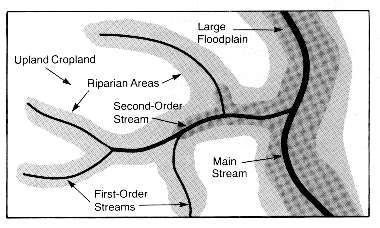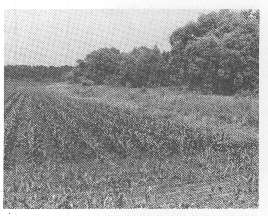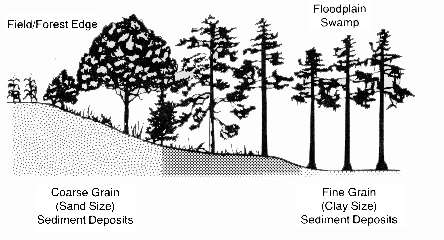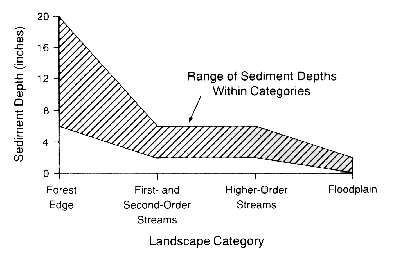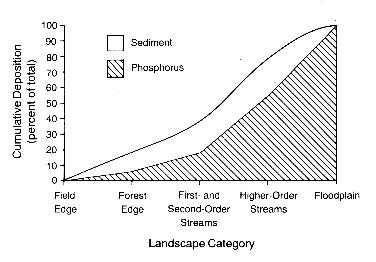The transitional areas between upland and water are often composed of "wet" soils that are known as wetlands. In their natural state, wetlands provide habitat and food sources for hundreds of plant and animal species, and some contribute to water quality. On the other hand, drained wetlands are among the most productive agricultural and forest soils in North Carolina; and, in many eastern counties, developed wetlands are a valuable part of the tax base. Thus, there is considerable pressure to allow development of these areas.
Most wetlands are privately owned, but their protection has become a public concern that is currently focused on the role of wetlands in improving water quality and as a habitat for wildlife. This fact sheet addresses the issue of water quality.
Contrary to popular belief, not all wetlands contribute equally to water quality. While some wetlands impede drainage flow from developed land, filtering out pollutants and greatly improving the quality of the water entering streams, others provide no significant water-quality benefits. This fact sheet explains how wetland type and location influence water quality, and it reviews the cases for development or preservation.
Wetland Types
Several classification systems have been developed to distinguish wetland types. Within most systems, wetland categories do not indicate their water quality value. Rather, categories are named for the most prevalent plant species; typical categories include bottomland hardwood forest, pine savanna, and pocosin (ever-green shrub bog). For the purpose of evaluating water-quality benefits, wetlands can be separated into two broad categories: riparian wetlands* and interstream divide wetlands.
Riparian wetlands are typically narrow, wet areas that are adjacent to streams and are periodically soaked because both surface and subsurface water flows toward them. The soils are usually alluvial (water deposited). Wet areas on interstream divides are generally large and nonalluvial. They result from poor drainage in flat areas where rainfall exceeds evapotranspiration. Even though riparian and interstream divide wetlands may be equally wet, they make different contributions to water quality.
When evaluating how wetlands influence water quality, natural vegetation must be carefully considered. In their natural state, both riparian wetlands and interstream divide wetlands are forested or have other shrub or scrub vegetation. These undeveloped vegetated areas are a prominent feature of North Carolina's landscape, and most rural landscapes are at least 50 percent forested. Many of these areas are wetlands today because better-drained land was cleared and developed first.
*In this publication, the term riparian wetlands generally refers to areas of wet soils adjacent to streams. Actually, these areas may or may not be sufficiently wet to be jurisdictional wetlands according to criteria contained in the 1989 Federal Manual (EPA, 1989), or the 1991 proposed criteria (Federal Register, 1991). Delineation criteria are discussed in Extension publication AG-439-26, Wetland Issues, by J. P. Lilly. ↲
Wetlands and Surface Water Quality
Benefits of Riparian Wetlands
The landscape position of a riparian-type wetland is shown schematically in Figure 1. Drainage water leaving either rural or urban uplands must pass through the riparian area before reaching the stream. During that journey, chemical, physical, and biological processes in the riparian area have the opportunity to alter the quality of the water reaching the stream.
Removing Nitrate-Nitrogen
In the early 1980s, several independent research groups, including one in North Carolina, investigated how wooded riparian areas reduce pollution in water flow originating from upland areas, such as agricultural fields. Although the groups used somewhat different approaches, their results were similar.
Runoff water from developed areas, like agricultural fields, often contains large amounts of nitrate- nitrogen (NO3-N) and phosphorus, which are nutrients essential to crop growth but harmful to humans and animals in high doses. In addition, excess nutrients in receiving waters can stimulate algae growth and, as a result, deplete the supply of oxygen necessary to fish and disrupt the aquatic food chain. The researchers found that a large percentage of the nitrate-nitrogen was removed from the subsurface flow as it passed through the riparian areas.
In one North Carolina wetland, the nitrate-nitrogen in the shallow groundwater that passed through the riparian vegetation was reduced from approximately 15 milligrams per liter to 2 milligrams per liter or less.1 (The current EPA drinking water standard is 10 milligrams of NO3-N per liter of water). The reduction occurred as the water passed through the first 30 to 50 feet of the riparian areas.
Researchers estimated that movement through the riparian areas reduced the nitrate-nitrogen content of the upland runoff nearly 85 percent annually, from 27 pounds of NO3-N per acre at the agricultural field edge to approximately 4 pounds per acre at the wetland edge near the streams.2 Most of the nitrate- nitrogen was removed as the flow passed through the narrow bands of vegetation between the agricultural fields and the small streams. The soils in the large downstream areas of wooded wetland (shown schematically in Figure 2) contributed little to the overall drop in nitrate-nitrogen.
Most researchers surmise that the nitrate-nitrogen is removed through a biological process known as denitrification. In denitrifcation, soil bacteria convert nitrate-nitrogen to nitrogen gas, which eventually returns to the atmosphere. Although both the narrow areas of vegetation and the large downstream areas can process nitrogen through denitrification, most of this nutrient is removed before the water reaches the downstream areas. Therefore, from the standpoint of water-quality improvement, the location of the wetland (or wet soils) is apparently much more important than either the degree of wetness or the size of the wet area. Soils immediately adjacent to streams (Figure 2), which are wet because they receive surface or subsurface flows from higher elevations, are the most effective at removing nitrate- nitrogen from agricultural and other runoff waters.
Trapping Sediment and Phosphorus
Researchers also found that riparian wetlands remove large amounts of sediment and phosphorus from surface runoff. Figure 3 shows the dense vegetative growth usually present at the field-forest edge of riparian areas. This growth slows the flow of the surface water, depositing much of the coarser sediment, as shown schematically in Figure 4. As the water moves further through the wetland into the higher- order streams and finally into the floodplain swamp (Figure 5), the texture of the deposited sediments becomes finer and finer. By the time it reaches the floodplain swamp, the sediment layer is extremely thin and consists mostly of clay-sized particles.
One study estimated the effect of riparian wetlands on the deposition of sediment and phosphorus leaving agricultural land in surface runoff.3 The researchers found that most of the sediment was deposited in the riparian area very close to the edge of the fields (Figure 6). Extrapolating the results, they estimated that 85 to 90 percent of the sediment remained trapped in wooded areas (Figure 7) and never reached major streams.
Data gathered in 1991 indicated that a vegetated buffer 13 feet wide trapped approximately 85 percent as much sediment as a buffer 26 feet wide.4 This suggests that the first few yards of the riparian area are not only the most effective at removing nitrate-nitrogen, they are also the most efficient at trapping sediment.
Another sediment study measured the phosphorus deposited with the sediment in the wooded wetland over a 25-year period.5 (Nitrate-nitrogen dissolves in water, but phosphorus will attach to soil particles.) The fine sediment deposited around th higher-order streams and in the floodplain swamps contained a higher concentration of phosphorus than the coarse materials found at the edge of the forest. Further, the floodplain deposits contained even more phosphorus than the higher-order stream areas, even though the floodplain accumulated sediment more slowly (Figure 7). The researchers concluded that the large floodplain swamps were more important for retaining phosphorus than for their ability to remove nitrate-nitrogen or trap sediment.
Benefits of Interstream Divide Wetlands
On the interstream divides of North Carolina's coastal plain and tidewater regions there are large areas of wet soils or wetlands.6 For illustration, Figure 8 shows a cross section of soil-wetness relations in the lower coastal plain. Two areas of wet soils are indicated: one small area immediately adjacent to the stream (riparian wetland), and another much larger area located some distance from the stream(interstream divide). Notice that the wet soils on the interstream divide are at the highest elevation, upslope from the stream. Wetlands called pocosins are the best-known example of poorly drained soils on interstream divides in both North and South Carolina.
Interstream divide soils are wet for two major geographic reasons: (1) The areas are relatively flat, so water moves slowly across the soil surface; and (2) they often are located miles from a naturally occurring drainage outlet, which means that excess rainfall can take several weeks to dissipate. The degree of wetness depends primarily on rainfall and evapotranspiration. During the winter and spring, when rainfall greatly exceeds evapotranspiration, water often pools on the soil surface. During the summer and fall, when evapotranspiration more closely equals rainfall, the soil dries faster and the water table often drops more than 3 feet below the soil surface.
Diluting Pollutant Concentrations
Interstream divide wetlands do not remove pollutants from surface runoff water because they receive no runoff water. Rather, interstream divide wetlands slowly contribute to surface runoff, serving as sources of water that flow downstream from their high elevations. This runoff (usually rainwater) is generally fresh; wet soils on undeveloped interstream divides are unfertilized and therefore have very few plant nutrients, such as nitrate-nitrogen and phosphorus.7
Fresh-but nutrient-poor-runoff from the interstream divide wetlands eventually mixes with the nutrient- rich runoff from the developed lands closer to the streams. This blending dilutes the pollutants in the runoff without diminishing the beneficial amounts of nutrients and sediments reaching the stream. Thus, interstream divide wetlands make a passive contribution to surface water quality.
Sink for Pumped Agricultural Drainage
Some researchers observed that concentrations of plant nutrients and sediment in agricultural drainage water were reduced 30 to 100 percent when the water was pumped into a wetland instead of being discharged directly into the stream.8 The longer the drainage water remained in the wetland, the smaller the concentrations of pollutants reaching the stream. Small amounts of pumped water remained completely in the wetland, along with all the pollutants. As the volume and speed of the runoff increased, so did the amount of nutrients and sediment reaching the stream.
Undeveloped interstream divide wetlands can be used as a sink for agricultural drainage, but a pump must be used to lift the drainage water over the flat land, and a diffuser canal is needed to distribute it evenly. Without the diffuser canal, runoff channels soon develop, reducing the amount of time the drainage water remains in the wetland and thereby reducing the benefits. Because interstream divide wetlands must be extensively modified to act as a sink, this water-quality benefit is marginal.
Wetlands and Groundwater Quality
A generally accepted "half truth" is that wetlands contribute significantly to groundwater quality and quantity. In fact, water that percolates through unfertilized wetland soils into the existing groundwater supply is of good quality but rarely substantial in quantity. Wetlands are wet for one or both of these reasons: (1) They receive a large volume of water from surface runoff or rainfall or (2) water percolates very slowly through their soils. Consequently, where percolation is small, the quantity of groundwater recharge is also small.
Benefits of Riparian Wetlands
Riparian wetlands receive a large volume of runoff from upslope areas, such as agricultural fields or interstream divide wetlands. This water moves quickly across the soil surface on its way toward an outlet; although many pollutants are removed and trapped, the water does not have time to recharge the groundwater. Further, riparian areas adjacent to streams actually discharge groundwater into streams.
Benefits of Interstream Divide Wetlands
Because interstream divide wetlands are usually at the highest elevations, their primary source of water is rainfall. This water remains fresh because the wet soils are unfertilized; however, only a small amount of it ever reaches the groundwater supply. Because the land is flat and poorly drained, the rainfall percolates very slowly through the wet soils. Citing conditions in North Carolina, one researcher estimated that groundwater recharge rates from poorly drained wet soils are typically less than 250,000 gallons per day per square mile (less than about 1 inch per year).9 Recharge rates through well-drained soils can exceed 10 inches per year.
Comparing Water-Quality Benefits
Wetlands, in general, provide water-quality benefits, but water-quality benefits are not derived equally from all wetlands. As explained in this fact sheet, riparian and interstream divide wetlands make very different contributions. Speaking strictly from the standpoint of water quality, the facts support preserving riparian wetlands. Interstream divide wetlands are clearly of less value to water quality and,in some cases, may be more valuable when developed for other uses.
Everyone who has studied riparian wetlands agrees that they provide many water-quality benefits. These are the areas that first receive and impede- drainage runoff from developed lands. They are also the areas where shallow groundwater seeps into surface waters. Riparian vegetation traps sediment, removing harmful amounts of nitrate-nitrogen, phosphorus, and pesticides before they can enter streams. For all these reasons, there should be a strong effort to maintain or restore wet, vegetated buffers adjacent to streams.
Although there are valid environmental reasons to preserve or restore some of the large wet areas on interstream divides, water-quality benefits are not among them. Available data suggest that natural interstream divide wetlands have only a passive, limited effect on water quality. To increase their water quality benefits, the wetlands must be extensively modified. On the other hand, when interstream divide soils are drained and used for agricultural production, they retain far more sediments and plant nutrients than many other well-drained North Carolina soils used for the same purpose.10
From a water-quality viewpoint, the facts support preserving or restoring riparian areas close to the streams. Then, to maintain a base of highly productive, fertile cropland, some interstream divide wetlands could be developed to compensate for croplands restored as riparian wetlands. The net result would be a general improvement in water quality.
Status of Wetlands Today
The loss of wetlands has received much publicity. The U.S. Fish and Wildlife Service estimates that 50 percent of the original wetlands in North Carolina have been converted to other uses. Most of the remaining 5 million acres are located near the interstream divides. Probably 20 percent of existing wetlands (about 1 million acres) are riparian areas adjacent to streams and therefore provide significant water-quality benefits. An additional 300,000 to 500,000 acres could be restored as narrow, vegetated strips. These strips would act as a buffer between small streams and major drainage flows from agricultural and other developed areas. A critical question that cannot be answered with available information is how wide these vegetated buffers must be for adequate or cost-effective water-quality protection.
The Next Step
Until wetland restoration and protection policies allow for the functional differences in wetland benefits, disagreement about their status surely will continue. To this end, progress is being made in North Carolina. The state has developed a wetland rating system that will be used to assess the value of individual wetlands. To determine the overall impact of development or preservation, the system will consider the importance of each benefit and the extent to which the wetland provides that benefit. Such a system is essential for appraising a wetland's contribution to water quality.
References Cited
- Jacobs, T. J., and J. W. Gilliam. 1985. Riparian losses of nitrate from agricultural drainage waters. J. Environ. Qual. 14:472-478. ↲
- Cooper, J. R., and J. W. Gilliam. 1987a. Phosphorus redistribution from cultivatedfields into riparian areas. Soil Sci. Soc. Am. J. 51:1600-1604. ↲
- Cooper, J. R., J. W. Gilliam, R .B. Daniels, and W.P. Robarge. 1987b. Riparian areas as filters for agricultural sediment. Soil Soc. Am. Proc. 51:416-420. ↲
- Parsons, J. E., R. B. Daniels, J. W. Gilliam, and T. A. Dillaha. 1991. The effect of vegetation filter strips on sediment and nutrient removal from agricultural runoff. In: Proceedings of the Environmentally Sound Agriculture conference in Orlando, Fla. April 16-18. In Press. ↲
- Cooper, J. R., J. W. Gilliam, R. B. Daniels, and W. P. Robarge. 1987b. Riparian areas as fillers for agricultural sediment. Soil Soc. Am. Proc. 51:416-420. ↲
- Daniels, R. B., H. J. Kleiss, S. W. Buol, H. J. Byrd, and J. A. Phillips. 1984. Soil systems in North Carolina. Bulletin 467. Raleigh, N.C.: North Carolina Agricultural Research Service. ↲
- Richardson, C. J., D. L. Tilton, J. A. Kadlec, J. P. M. Chamie, and W. A. Wetnz. 1978. Nutrient dynamics of northern wetland ecosystems. In: Freshwater Wetlands Ecological Processes and Management Potential, (eds.) R. E. Good, et al. New York: Academic Press. pp. 217-241. ↲
- Chescheir, G. M., J. W. Gilliam, R. W. Skaggs, and R. B. Broadhead. 1991. Nutrient and sediment removal in forested wetlands receiving pumped agricultural drainage water. Wetlands 11(1):87-103. ↲
- Heath, R. C. 1980. Basic elements of groundwater hydrology with reference to conditions in North Carolina. U.S. Geological Survey, Water Resources Investigations, Open File Report no. 80-44. 87 p. ↲
- Skaggs, R. W., J. W. Gilliam, T. J. Sheets, and J. S. Barnes. 1980. Effect of agricultural land development on drainage waters in the North Carolina Tidewater Region. Report no. 159. Water Resources Research Institute of the University of North Carolina. ↲
Publication date: Dec. 1, 1996
Reviewed/Revised: July 26, 2024
AG-473-7
N.C. Cooperative Extension prohibits discrimination and harassment regardless of age, color, disability, family and marital status, gender identity, national origin, political beliefs, race, religion, sex (including pregnancy), sexual orientation and veteran status.



